Organisational Behaviour Report: Motivation and Team Effectiveness
VerifiedAdded on 2023/01/12
|19
|3507
|31
Report
AI Summary
This report delves into the realm of organizational behaviour, applying its principles to the case of Bentley Motors. It begins with an assessment of how organizational culture, politics, and power dynamics impact team performance, drawing on Hofstede's cultural theory and Handy's power theory to provide a nuanced understanding. The report then evaluates various motivation techniques, including Maslow's and Herzberg's theories, as well as Vroom's and Adam's theories, to improve team performance. Furthermore, it illustrates different techniques for building effective teams, such as project teams, functional teams, virtual teams, and problem-solving teams. Finally, the report concludes by applying organizational behaviour philosophies to a business situation, offering insights into employee turnover. This report, contributing to the body of knowledge available on Desklib, serves as a valuable resource for students studying organizational behavior.
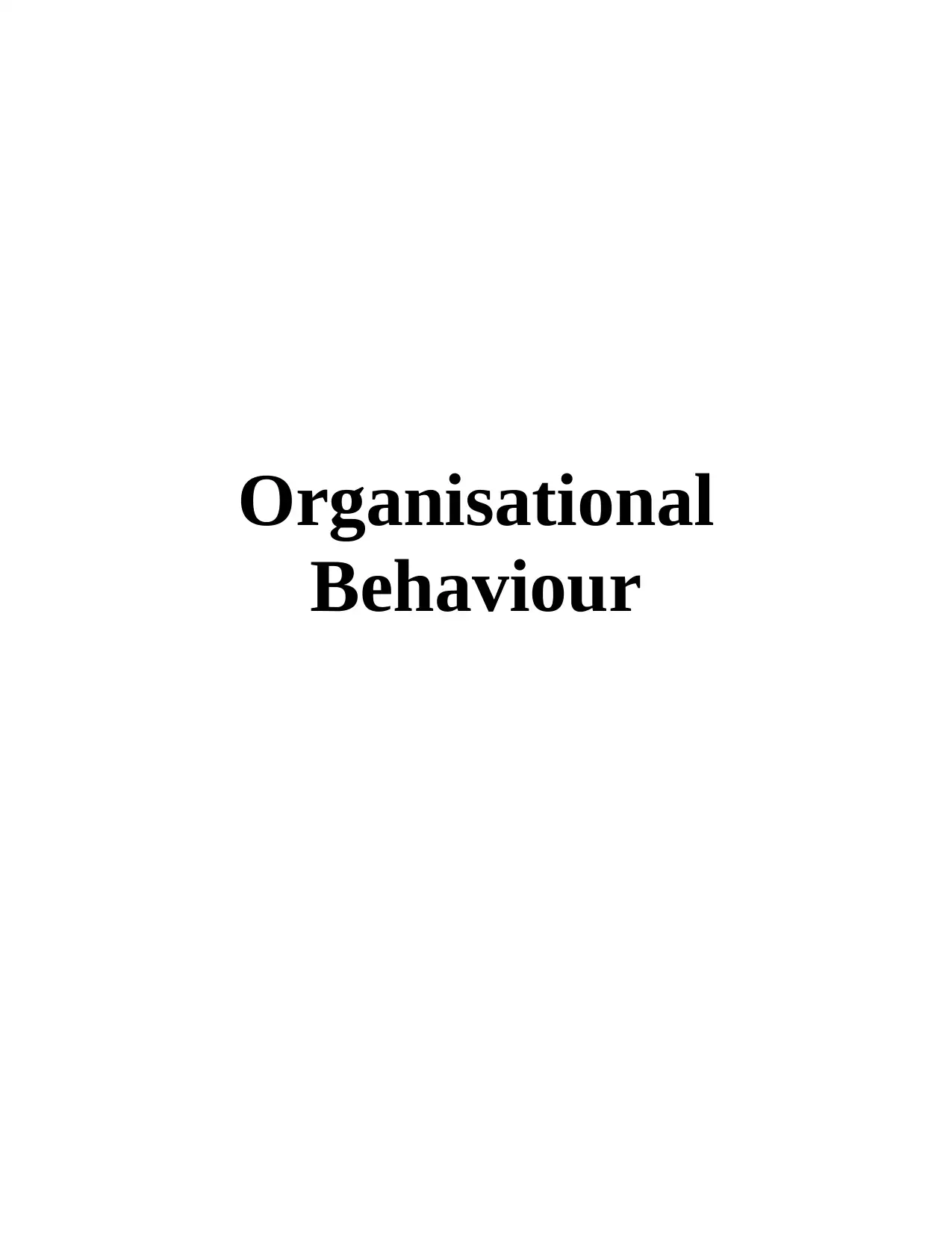
Organisational
Behaviour
Behaviour
Paraphrase This Document
Need a fresh take? Get an instant paraphrase of this document with our AI Paraphraser
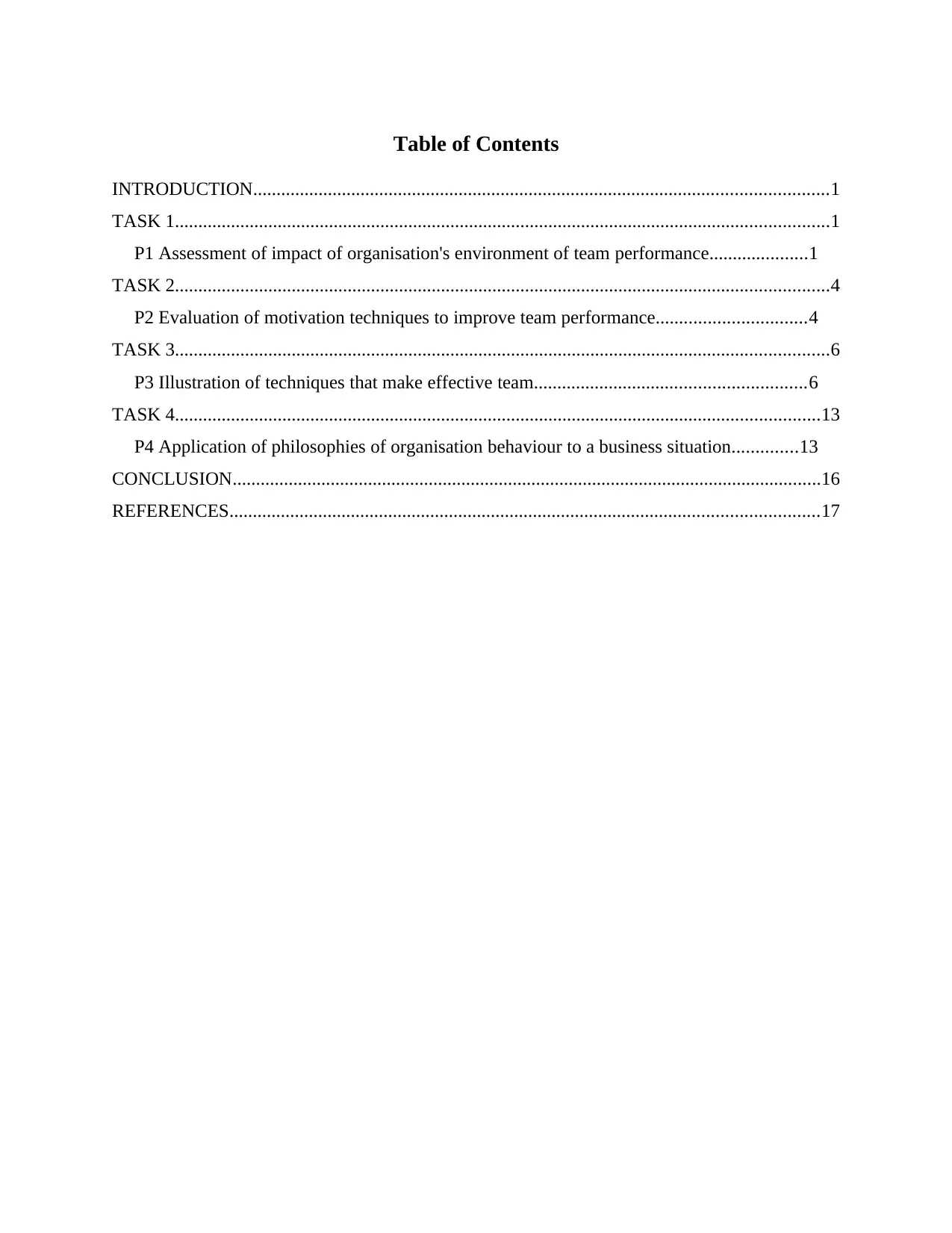
Table of Contents
INTRODUCTION...........................................................................................................................1
TASK 1............................................................................................................................................1
P1 Assessment of impact of organisation's environment of team performance.....................1
TASK 2............................................................................................................................................4
P2 Evaluation of motivation techniques to improve team performance................................4
TASK 3............................................................................................................................................6
P3 Illustration of techniques that make effective team..........................................................6
TASK 4..........................................................................................................................................13
P4 Application of philosophies of organisation behaviour to a business situation..............13
CONCLUSION..............................................................................................................................16
REFERENCES..............................................................................................................................17
INTRODUCTION...........................................................................................................................1
TASK 1............................................................................................................................................1
P1 Assessment of impact of organisation's environment of team performance.....................1
TASK 2............................................................................................................................................4
P2 Evaluation of motivation techniques to improve team performance................................4
TASK 3............................................................................................................................................6
P3 Illustration of techniques that make effective team..........................................................6
TASK 4..........................................................................................................................................13
P4 Application of philosophies of organisation behaviour to a business situation..............13
CONCLUSION..............................................................................................................................16
REFERENCES..............................................................................................................................17
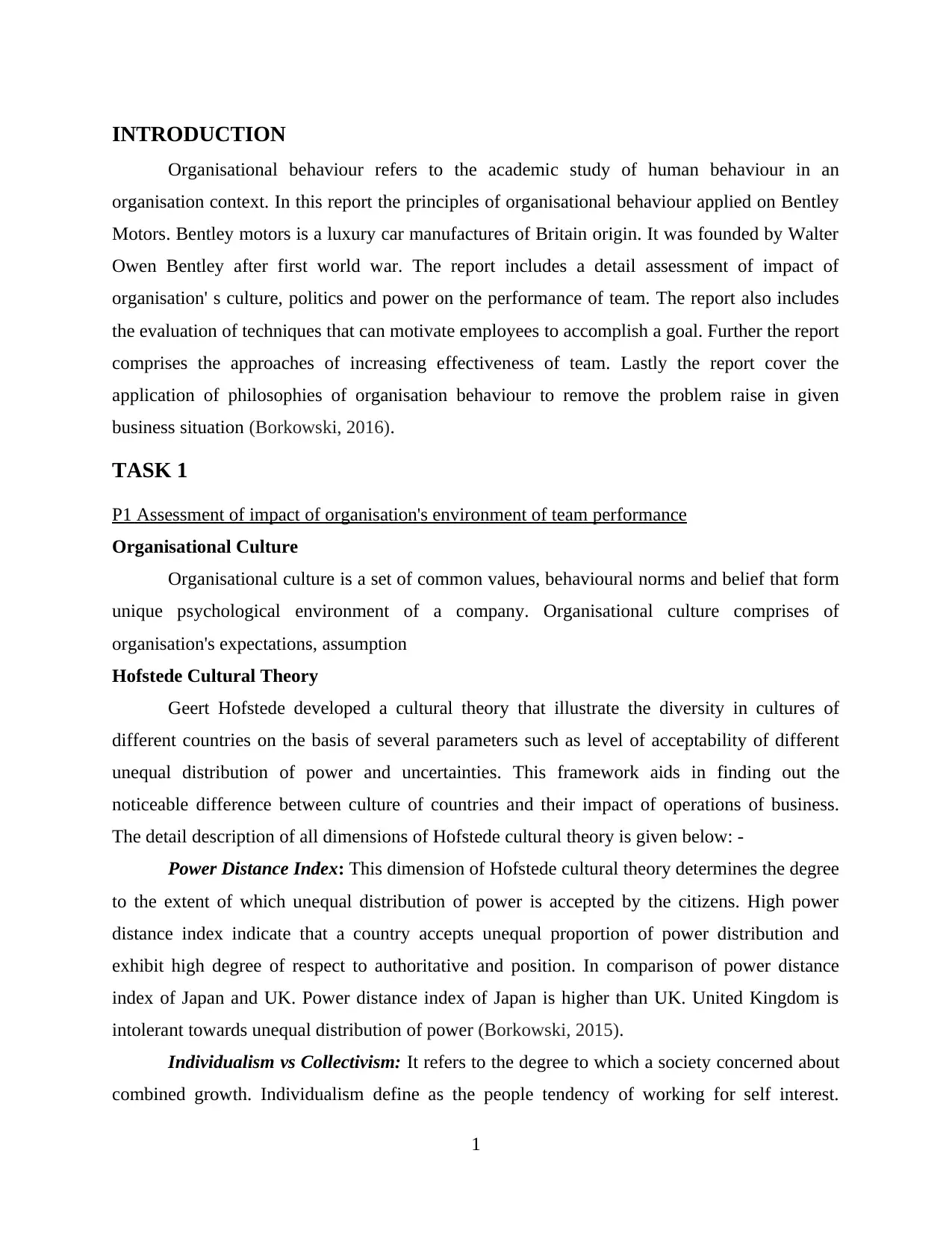
INTRODUCTION
Organisational behaviour refers to the academic study of human behaviour in an
organisation context. In this report the principles of organisational behaviour applied on Bentley
Motors. Bentley motors is a luxury car manufactures of Britain origin. It was founded by Walter
Owen Bentley after first world war. The report includes a detail assessment of impact of
organisation' s culture, politics and power on the performance of team. The report also includes
the evaluation of techniques that can motivate employees to accomplish a goal. Further the report
comprises the approaches of increasing effectiveness of team. Lastly the report cover the
application of philosophies of organisation behaviour to remove the problem raise in given
business situation (Borkowski, 2016).
TASK 1
P1 Assessment of impact of organisation's environment of team performance
Organisational Culture
Organisational culture is a set of common values, behavioural norms and belief that form
unique psychological environment of a company. Organisational culture comprises of
organisation's expectations, assumption
Hofstede Cultural Theory
Geert Hofstede developed a cultural theory that illustrate the diversity in cultures of
different countries on the basis of several parameters such as level of acceptability of different
unequal distribution of power and uncertainties. This framework aids in finding out the
noticeable difference between culture of countries and their impact of operations of business.
The detail description of all dimensions of Hofstede cultural theory is given below: -
Power Distance Index: This dimension of Hofstede cultural theory determines the degree
to the extent of which unequal distribution of power is accepted by the citizens. High power
distance index indicate that a country accepts unequal proportion of power distribution and
exhibit high degree of respect to authoritative and position. In comparison of power distance
index of Japan and UK. Power distance index of Japan is higher than UK. United Kingdom is
intolerant towards unequal distribution of power (Borkowski, 2015).
Individualism vs Collectivism: It refers to the degree to which a society concerned about
combined growth. Individualism define as the people tendency of working for self interest.
1
Organisational behaviour refers to the academic study of human behaviour in an
organisation context. In this report the principles of organisational behaviour applied on Bentley
Motors. Bentley motors is a luxury car manufactures of Britain origin. It was founded by Walter
Owen Bentley after first world war. The report includes a detail assessment of impact of
organisation' s culture, politics and power on the performance of team. The report also includes
the evaluation of techniques that can motivate employees to accomplish a goal. Further the report
comprises the approaches of increasing effectiveness of team. Lastly the report cover the
application of philosophies of organisation behaviour to remove the problem raise in given
business situation (Borkowski, 2016).
TASK 1
P1 Assessment of impact of organisation's environment of team performance
Organisational Culture
Organisational culture is a set of common values, behavioural norms and belief that form
unique psychological environment of a company. Organisational culture comprises of
organisation's expectations, assumption
Hofstede Cultural Theory
Geert Hofstede developed a cultural theory that illustrate the diversity in cultures of
different countries on the basis of several parameters such as level of acceptability of different
unequal distribution of power and uncertainties. This framework aids in finding out the
noticeable difference between culture of countries and their impact of operations of business.
The detail description of all dimensions of Hofstede cultural theory is given below: -
Power Distance Index: This dimension of Hofstede cultural theory determines the degree
to the extent of which unequal distribution of power is accepted by the citizens. High power
distance index indicate that a country accepts unequal proportion of power distribution and
exhibit high degree of respect to authoritative and position. In comparison of power distance
index of Japan and UK. Power distance index of Japan is higher than UK. United Kingdom is
intolerant towards unequal distribution of power (Borkowski, 2015).
Individualism vs Collectivism: It refers to the degree to which a society concerned about
combined growth. Individualism define as the people tendency of working for self interest.
1
⊘ This is a preview!⊘
Do you want full access?
Subscribe today to unlock all pages.

Trusted by 1+ million students worldwide
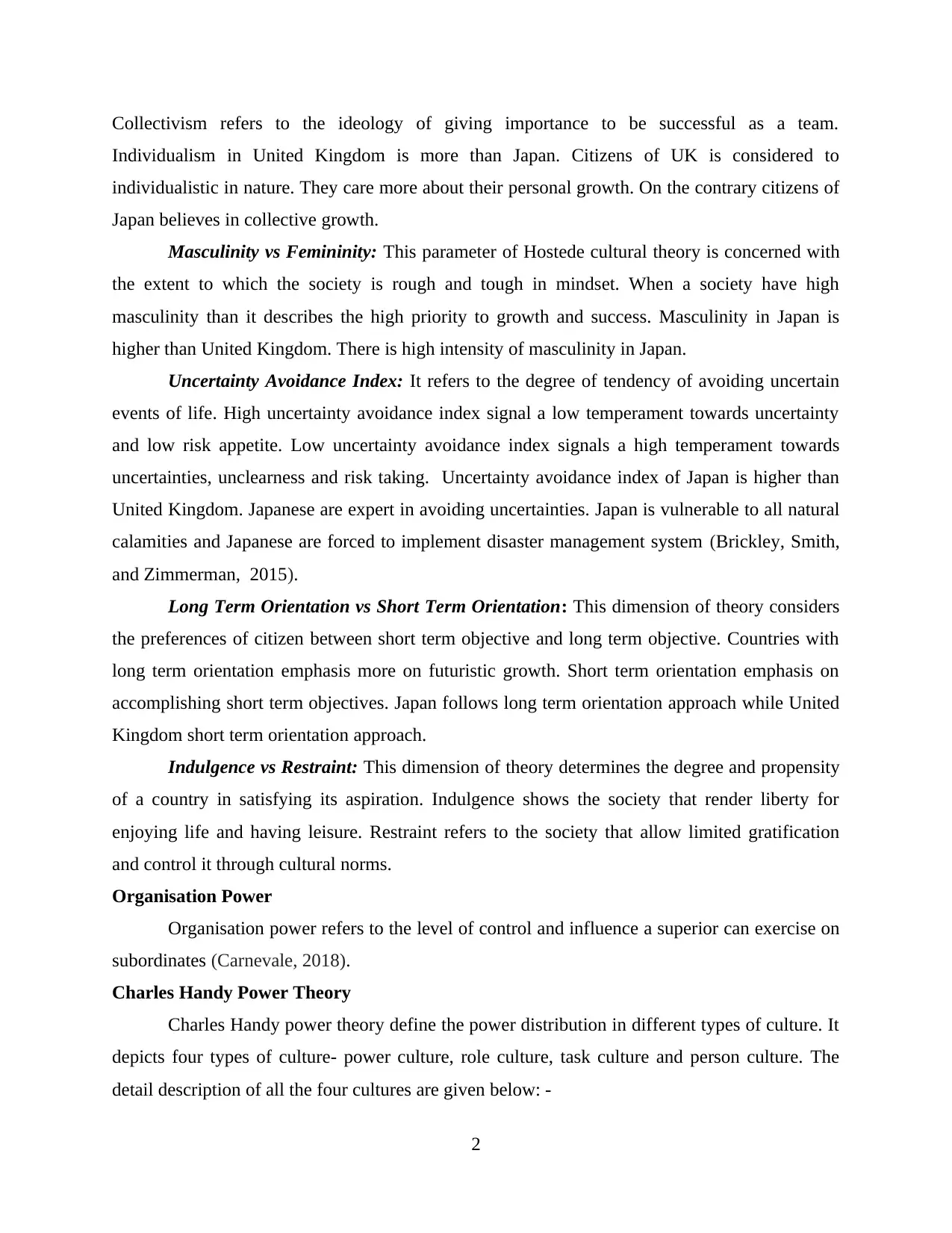
Collectivism refers to the ideology of giving importance to be successful as a team.
Individualism in United Kingdom is more than Japan. Citizens of UK is considered to
individualistic in nature. They care more about their personal growth. On the contrary citizens of
Japan believes in collective growth.
Masculinity vs Femininity: This parameter of Hostede cultural theory is concerned with
the extent to which the society is rough and tough in mindset. When a society have high
masculinity than it describes the high priority to growth and success. Masculinity in Japan is
higher than United Kingdom. There is high intensity of masculinity in Japan.
Uncertainty Avoidance Index: It refers to the degree of tendency of avoiding uncertain
events of life. High uncertainty avoidance index signal a low temperament towards uncertainty
and low risk appetite. Low uncertainty avoidance index signals a high temperament towards
uncertainties, unclearness and risk taking. Uncertainty avoidance index of Japan is higher than
United Kingdom. Japanese are expert in avoiding uncertainties. Japan is vulnerable to all natural
calamities and Japanese are forced to implement disaster management system (Brickley, Smith,
and Zimmerman, 2015).
Long Term Orientation vs Short Term Orientation: This dimension of theory considers
the preferences of citizen between short term objective and long term objective. Countries with
long term orientation emphasis more on futuristic growth. Short term orientation emphasis on
accomplishing short term objectives. Japan follows long term orientation approach while United
Kingdom short term orientation approach.
Indulgence vs Restraint: This dimension of theory determines the degree and propensity
of a country in satisfying its aspiration. Indulgence shows the society that render liberty for
enjoying life and having leisure. Restraint refers to the society that allow limited gratification
and control it through cultural norms.
Organisation Power
Organisation power refers to the level of control and influence a superior can exercise on
subordinates (Carnevale, 2018).
Charles Handy Power Theory
Charles Handy power theory define the power distribution in different types of culture. It
depicts four types of culture- power culture, role culture, task culture and person culture. The
detail description of all the four cultures are given below: -
2
Individualism in United Kingdom is more than Japan. Citizens of UK is considered to
individualistic in nature. They care more about their personal growth. On the contrary citizens of
Japan believes in collective growth.
Masculinity vs Femininity: This parameter of Hostede cultural theory is concerned with
the extent to which the society is rough and tough in mindset. When a society have high
masculinity than it describes the high priority to growth and success. Masculinity in Japan is
higher than United Kingdom. There is high intensity of masculinity in Japan.
Uncertainty Avoidance Index: It refers to the degree of tendency of avoiding uncertain
events of life. High uncertainty avoidance index signal a low temperament towards uncertainty
and low risk appetite. Low uncertainty avoidance index signals a high temperament towards
uncertainties, unclearness and risk taking. Uncertainty avoidance index of Japan is higher than
United Kingdom. Japanese are expert in avoiding uncertainties. Japan is vulnerable to all natural
calamities and Japanese are forced to implement disaster management system (Brickley, Smith,
and Zimmerman, 2015).
Long Term Orientation vs Short Term Orientation: This dimension of theory considers
the preferences of citizen between short term objective and long term objective. Countries with
long term orientation emphasis more on futuristic growth. Short term orientation emphasis on
accomplishing short term objectives. Japan follows long term orientation approach while United
Kingdom short term orientation approach.
Indulgence vs Restraint: This dimension of theory determines the degree and propensity
of a country in satisfying its aspiration. Indulgence shows the society that render liberty for
enjoying life and having leisure. Restraint refers to the society that allow limited gratification
and control it through cultural norms.
Organisation Power
Organisation power refers to the level of control and influence a superior can exercise on
subordinates (Carnevale, 2018).
Charles Handy Power Theory
Charles Handy power theory define the power distribution in different types of culture. It
depicts four types of culture- power culture, role culture, task culture and person culture. The
detail description of all the four cultures are given below: -
2
Paraphrase This Document
Need a fresh take? Get an instant paraphrase of this document with our AI Paraphraser
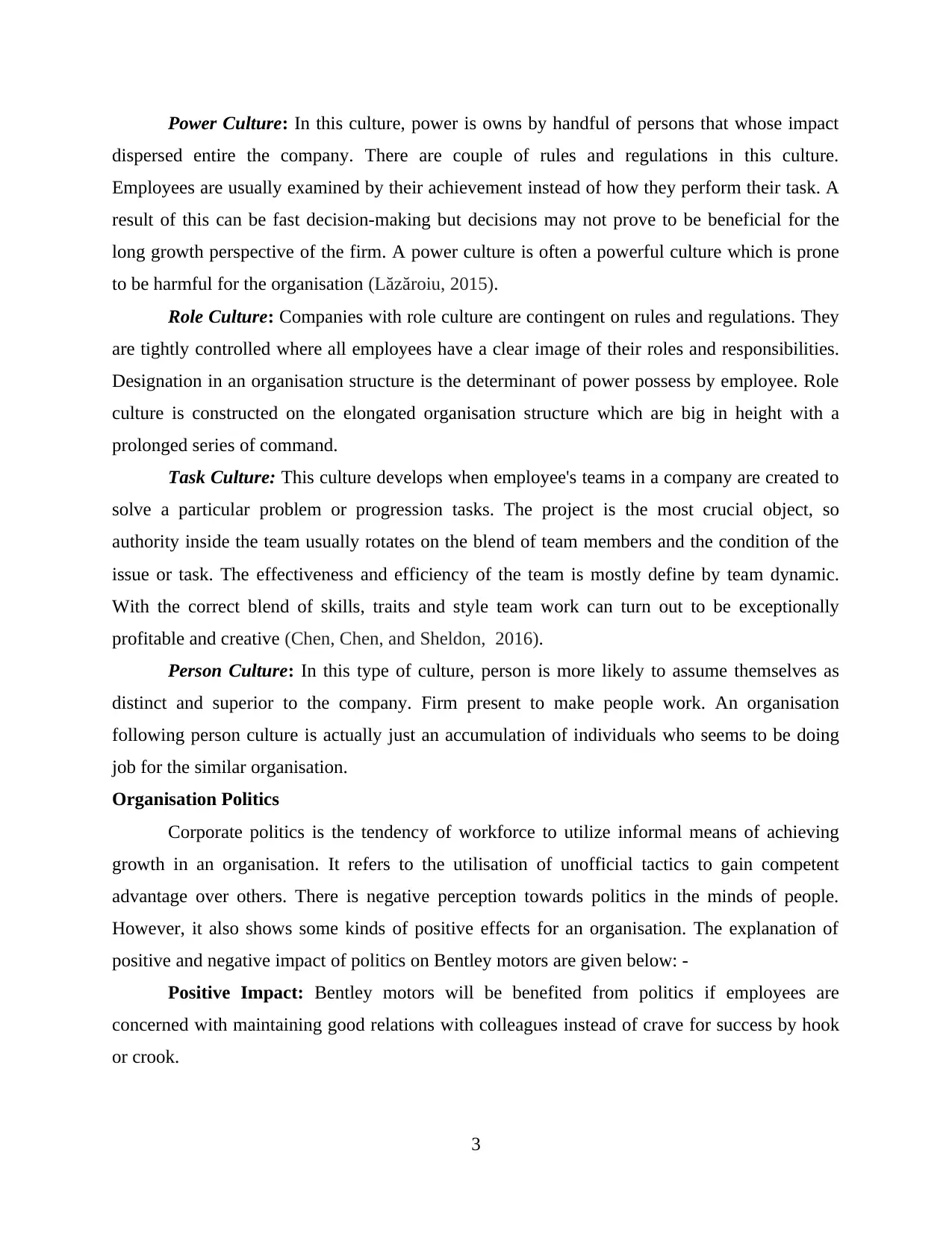
Power Culture: In this culture, power is owns by handful of persons that whose impact
dispersed entire the company. There are couple of rules and regulations in this culture.
Employees are usually examined by their achievement instead of how they perform their task. A
result of this can be fast decision-making but decisions may not prove to be beneficial for the
long growth perspective of the firm. A power culture is often a powerful culture which is prone
to be harmful for the organisation (Lăzăroiu, 2015).
Role Culture: Companies with role culture are contingent on rules and regulations. They
are tightly controlled where all employees have a clear image of their roles and responsibilities.
Designation in an organisation structure is the determinant of power possess by employee. Role
culture is constructed on the elongated organisation structure which are big in height with a
prolonged series of command.
Task Culture: This culture develops when employee's teams in a company are created to
solve a particular problem or progression tasks. The project is the most crucial object, so
authority inside the team usually rotates on the blend of team members and the condition of the
issue or task. The effectiveness and efficiency of the team is mostly define by team dynamic.
With the correct blend of skills, traits and style team work can turn out to be exceptionally
profitable and creative (Chen, Chen, and Sheldon, 2016).
Person Culture: In this type of culture, person is more likely to assume themselves as
distinct and superior to the company. Firm present to make people work. An organisation
following person culture is actually just an accumulation of individuals who seems to be doing
job for the similar organisation.
Organisation Politics
Corporate politics is the tendency of workforce to utilize informal means of achieving
growth in an organisation. It refers to the utilisation of unofficial tactics to gain competent
advantage over others. There is negative perception towards politics in the minds of people.
However, it also shows some kinds of positive effects for an organisation. The explanation of
positive and negative impact of politics on Bentley motors are given below: -
Positive Impact: Bentley motors will be benefited from politics if employees are
concerned with maintaining good relations with colleagues instead of crave for success by hook
or crook.
3
dispersed entire the company. There are couple of rules and regulations in this culture.
Employees are usually examined by their achievement instead of how they perform their task. A
result of this can be fast decision-making but decisions may not prove to be beneficial for the
long growth perspective of the firm. A power culture is often a powerful culture which is prone
to be harmful for the organisation (Lăzăroiu, 2015).
Role Culture: Companies with role culture are contingent on rules and regulations. They
are tightly controlled where all employees have a clear image of their roles and responsibilities.
Designation in an organisation structure is the determinant of power possess by employee. Role
culture is constructed on the elongated organisation structure which are big in height with a
prolonged series of command.
Task Culture: This culture develops when employee's teams in a company are created to
solve a particular problem or progression tasks. The project is the most crucial object, so
authority inside the team usually rotates on the blend of team members and the condition of the
issue or task. The effectiveness and efficiency of the team is mostly define by team dynamic.
With the correct blend of skills, traits and style team work can turn out to be exceptionally
profitable and creative (Chen, Chen, and Sheldon, 2016).
Person Culture: In this type of culture, person is more likely to assume themselves as
distinct and superior to the company. Firm present to make people work. An organisation
following person culture is actually just an accumulation of individuals who seems to be doing
job for the similar organisation.
Organisation Politics
Corporate politics is the tendency of workforce to utilize informal means of achieving
growth in an organisation. It refers to the utilisation of unofficial tactics to gain competent
advantage over others. There is negative perception towards politics in the minds of people.
However, it also shows some kinds of positive effects for an organisation. The explanation of
positive and negative impact of politics on Bentley motors are given below: -
Positive Impact: Bentley motors will be benefited from politics if employees are
concerned with maintaining good relations with colleagues instead of crave for success by hook
or crook.
3
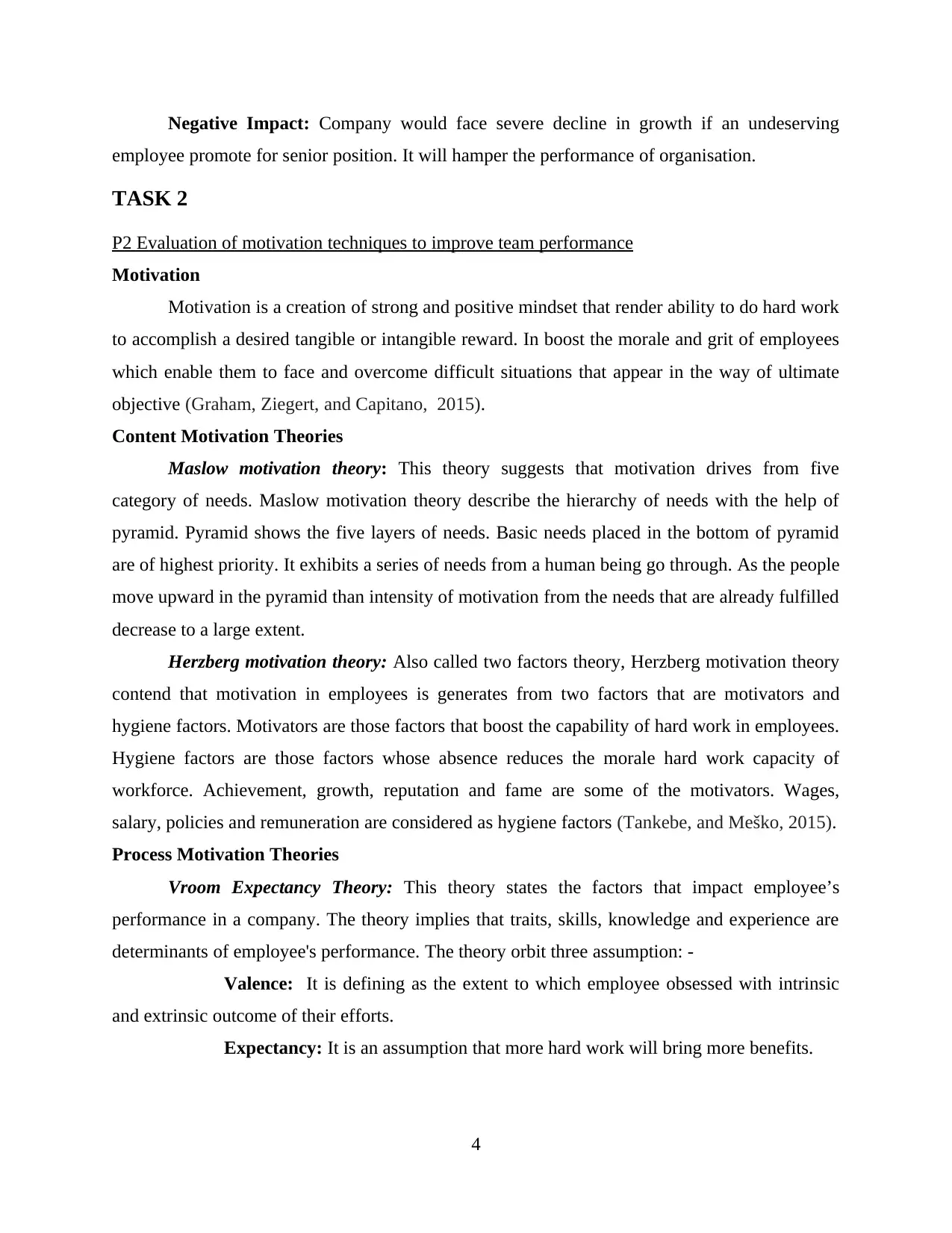
Negative Impact: Company would face severe decline in growth if an undeserving
employee promote for senior position. It will hamper the performance of organisation.
TASK 2
P2 Evaluation of motivation techniques to improve team performance
Motivation
Motivation is a creation of strong and positive mindset that render ability to do hard work
to accomplish a desired tangible or intangible reward. In boost the morale and grit of employees
which enable them to face and overcome difficult situations that appear in the way of ultimate
objective (Graham, Ziegert, and Capitano, 2015).
Content Motivation Theories
Maslow motivation theory: This theory suggests that motivation drives from five
category of needs. Maslow motivation theory describe the hierarchy of needs with the help of
pyramid. Pyramid shows the five layers of needs. Basic needs placed in the bottom of pyramid
are of highest priority. It exhibits a series of needs from a human being go through. As the people
move upward in the pyramid than intensity of motivation from the needs that are already fulfilled
decrease to a large extent.
Herzberg motivation theory: Also called two factors theory, Herzberg motivation theory
contend that motivation in employees is generates from two factors that are motivators and
hygiene factors. Motivators are those factors that boost the capability of hard work in employees.
Hygiene factors are those factors whose absence reduces the morale hard work capacity of
workforce. Achievement, growth, reputation and fame are some of the motivators. Wages,
salary, policies and remuneration are considered as hygiene factors (Tankebe, and Meško, 2015).
Process Motivation Theories
Vroom Expectancy Theory: This theory states the factors that impact employee’s
performance in a company. The theory implies that traits, skills, knowledge and experience are
determinants of employee's performance. The theory orbit three assumption: -
Valence: It is defining as the extent to which employee obsessed with intrinsic
and extrinsic outcome of their efforts.
Expectancy: It is an assumption that more hard work will bring more benefits.
4
employee promote for senior position. It will hamper the performance of organisation.
TASK 2
P2 Evaluation of motivation techniques to improve team performance
Motivation
Motivation is a creation of strong and positive mindset that render ability to do hard work
to accomplish a desired tangible or intangible reward. In boost the morale and grit of employees
which enable them to face and overcome difficult situations that appear in the way of ultimate
objective (Graham, Ziegert, and Capitano, 2015).
Content Motivation Theories
Maslow motivation theory: This theory suggests that motivation drives from five
category of needs. Maslow motivation theory describe the hierarchy of needs with the help of
pyramid. Pyramid shows the five layers of needs. Basic needs placed in the bottom of pyramid
are of highest priority. It exhibits a series of needs from a human being go through. As the people
move upward in the pyramid than intensity of motivation from the needs that are already fulfilled
decrease to a large extent.
Herzberg motivation theory: Also called two factors theory, Herzberg motivation theory
contend that motivation in employees is generates from two factors that are motivators and
hygiene factors. Motivators are those factors that boost the capability of hard work in employees.
Hygiene factors are those factors whose absence reduces the morale hard work capacity of
workforce. Achievement, growth, reputation and fame are some of the motivators. Wages,
salary, policies and remuneration are considered as hygiene factors (Tankebe, and Meško, 2015).
Process Motivation Theories
Vroom Expectancy Theory: This theory states the factors that impact employee’s
performance in a company. The theory implies that traits, skills, knowledge and experience are
determinants of employee's performance. The theory orbit three assumption: -
Valence: It is defining as the extent to which employee obsessed with intrinsic
and extrinsic outcome of their efforts.
Expectancy: It is an assumption that more hard work will bring more benefits.
4
⊘ This is a preview!⊘
Do you want full access?
Subscribe today to unlock all pages.

Trusted by 1+ million students worldwide
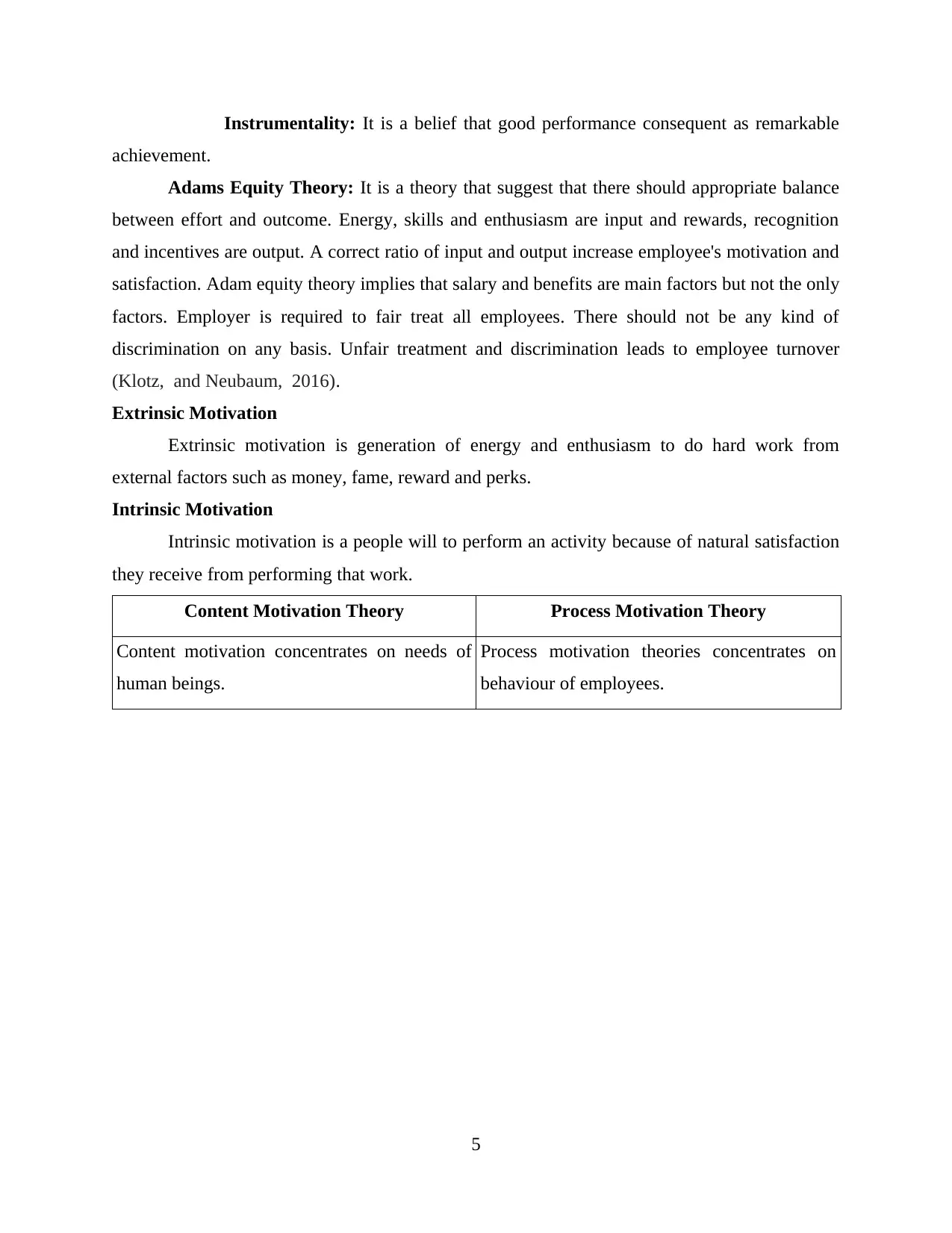
Instrumentality: It is a belief that good performance consequent as remarkable
achievement.
Adams Equity Theory: It is a theory that suggest that there should appropriate balance
between effort and outcome. Energy, skills and enthusiasm are input and rewards, recognition
and incentives are output. A correct ratio of input and output increase employee's motivation and
satisfaction. Adam equity theory implies that salary and benefits are main factors but not the only
factors. Employer is required to fair treat all employees. There should not be any kind of
discrimination on any basis. Unfair treatment and discrimination leads to employee turnover
(Klotz, and Neubaum, 2016).
Extrinsic Motivation
Extrinsic motivation is generation of energy and enthusiasm to do hard work from
external factors such as money, fame, reward and perks.
Intrinsic Motivation
Intrinsic motivation is a people will to perform an activity because of natural satisfaction
they receive from performing that work.
Content Motivation Theory Process Motivation Theory
Content motivation concentrates on needs of
human beings.
Process motivation theories concentrates on
behaviour of employees.
5
achievement.
Adams Equity Theory: It is a theory that suggest that there should appropriate balance
between effort and outcome. Energy, skills and enthusiasm are input and rewards, recognition
and incentives are output. A correct ratio of input and output increase employee's motivation and
satisfaction. Adam equity theory implies that salary and benefits are main factors but not the only
factors. Employer is required to fair treat all employees. There should not be any kind of
discrimination on any basis. Unfair treatment and discrimination leads to employee turnover
(Klotz, and Neubaum, 2016).
Extrinsic Motivation
Extrinsic motivation is generation of energy and enthusiasm to do hard work from
external factors such as money, fame, reward and perks.
Intrinsic Motivation
Intrinsic motivation is a people will to perform an activity because of natural satisfaction
they receive from performing that work.
Content Motivation Theory Process Motivation Theory
Content motivation concentrates on needs of
human beings.
Process motivation theories concentrates on
behaviour of employees.
5
Paraphrase This Document
Need a fresh take? Get an instant paraphrase of this document with our AI Paraphraser
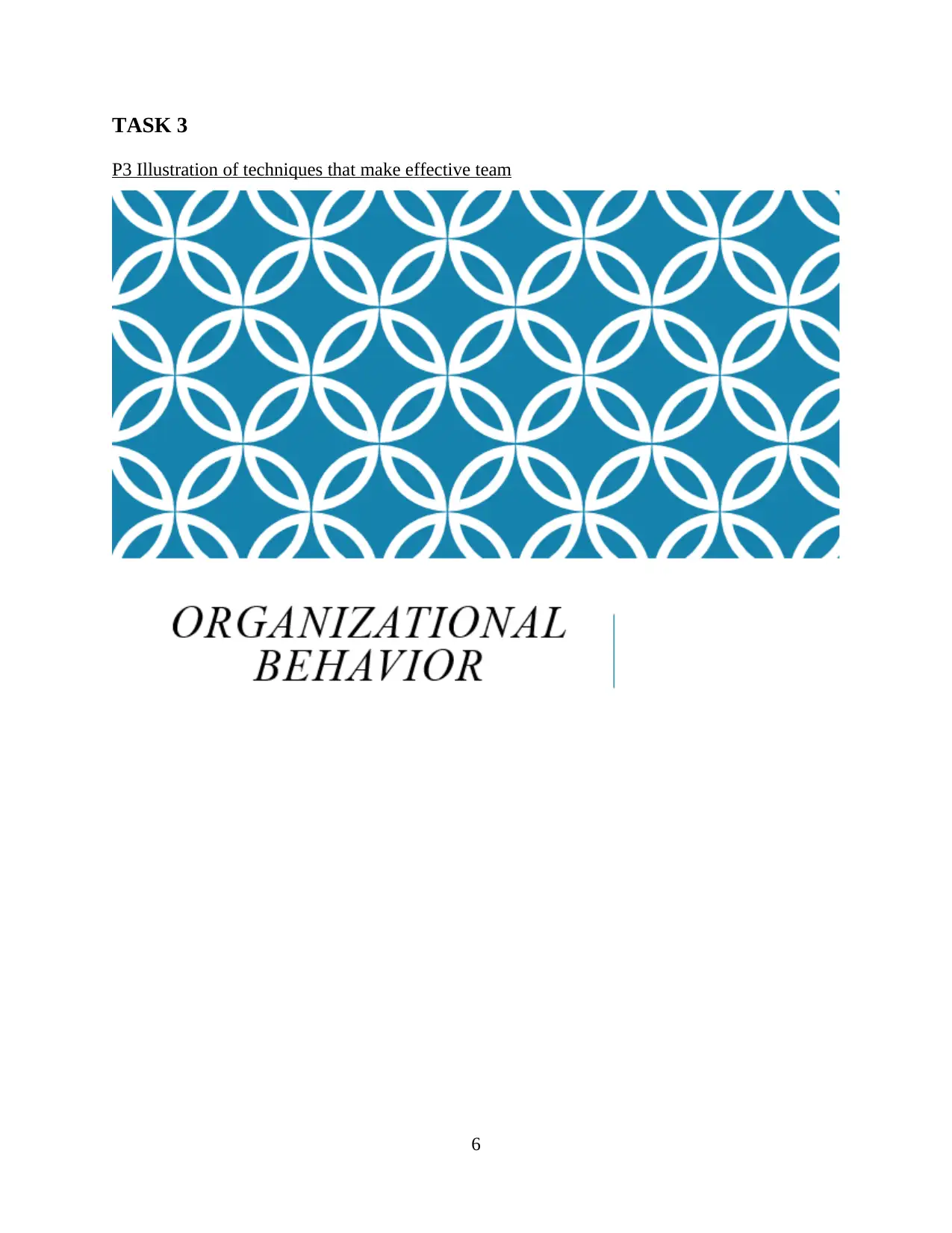
TASK 3
P3 Illustration of techniques that make effective team
6
P3 Illustration of techniques that make effective team
6
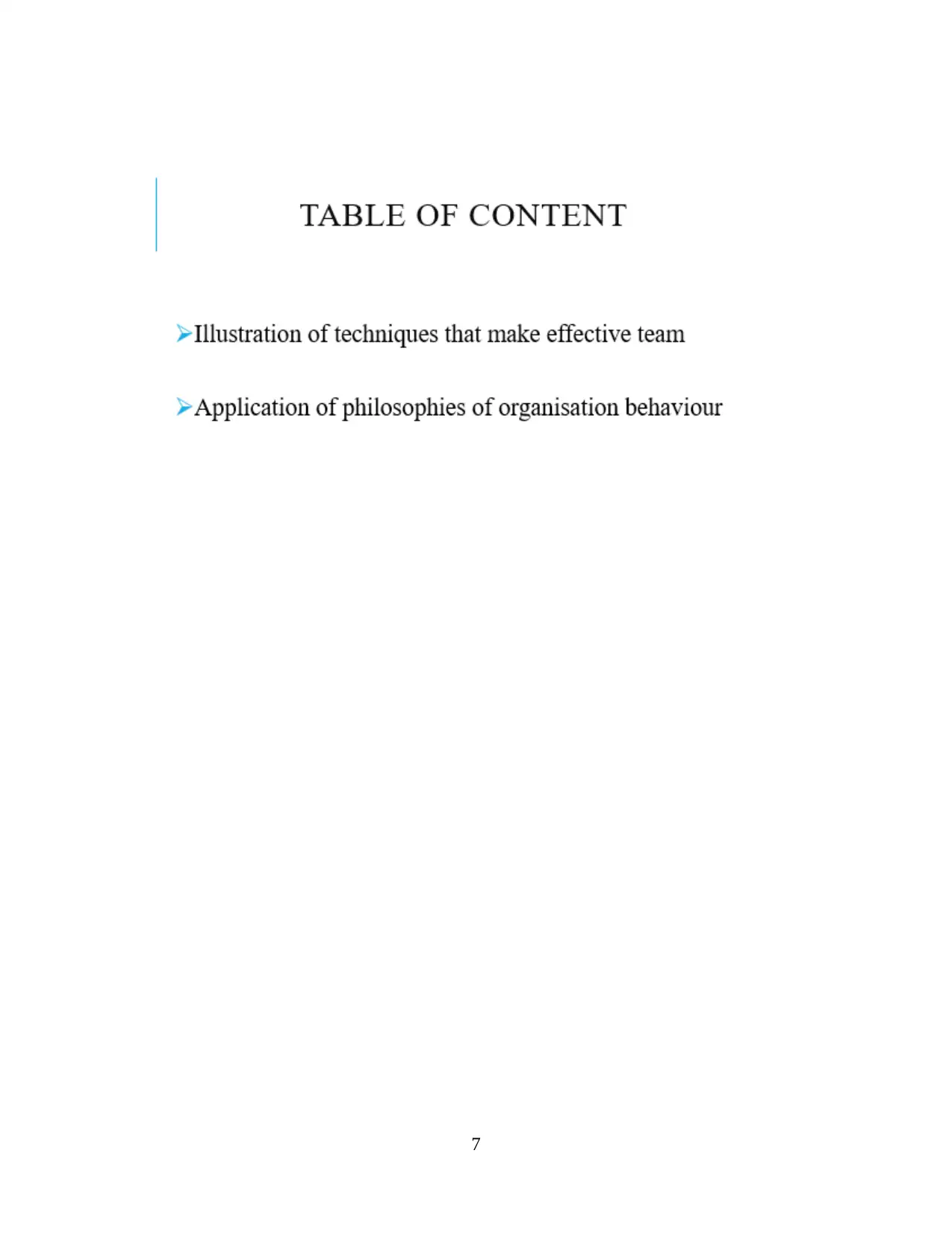
7
⊘ This is a preview!⊘
Do you want full access?
Subscribe today to unlock all pages.

Trusted by 1+ million students worldwide
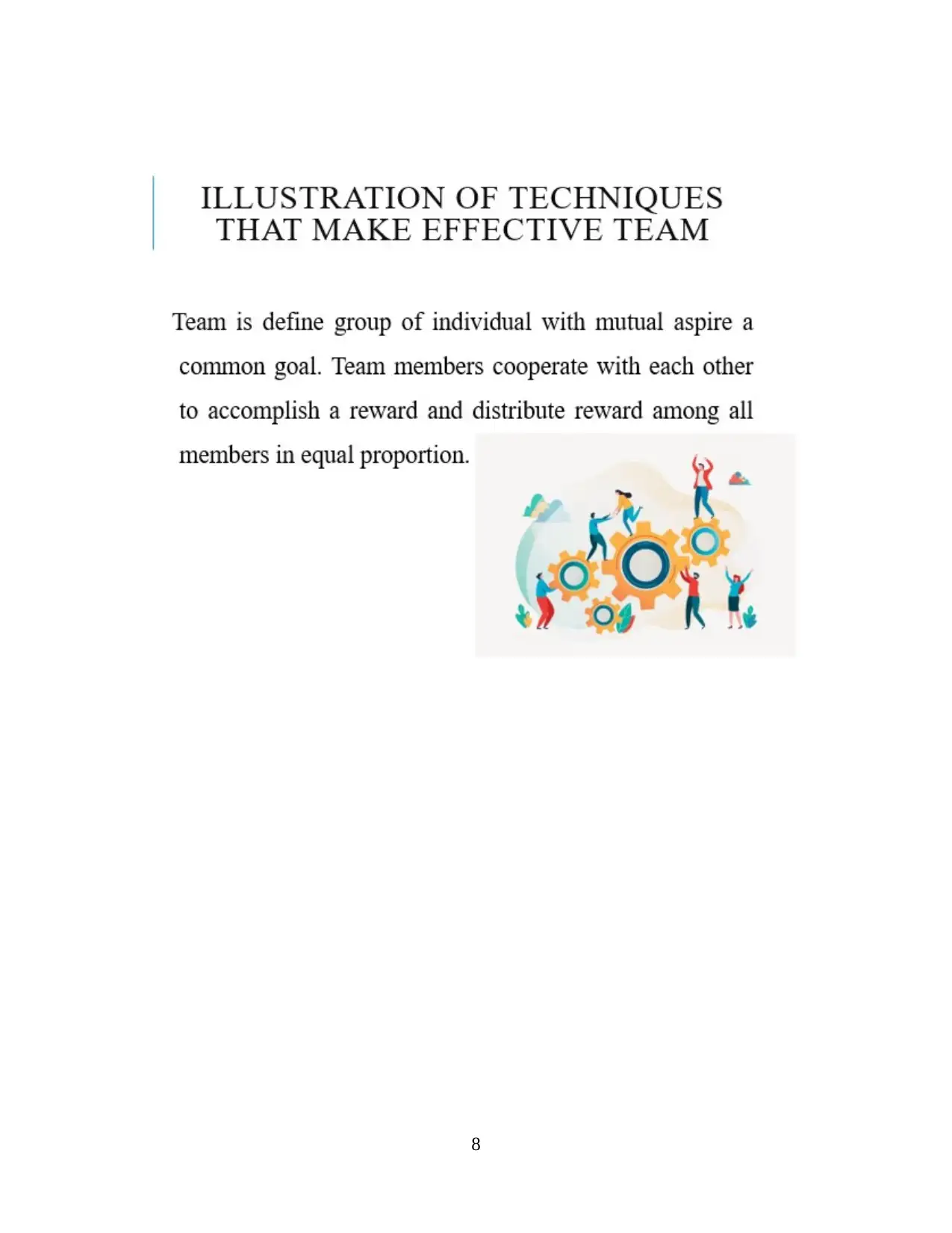
8
Paraphrase This Document
Need a fresh take? Get an instant paraphrase of this document with our AI Paraphraser
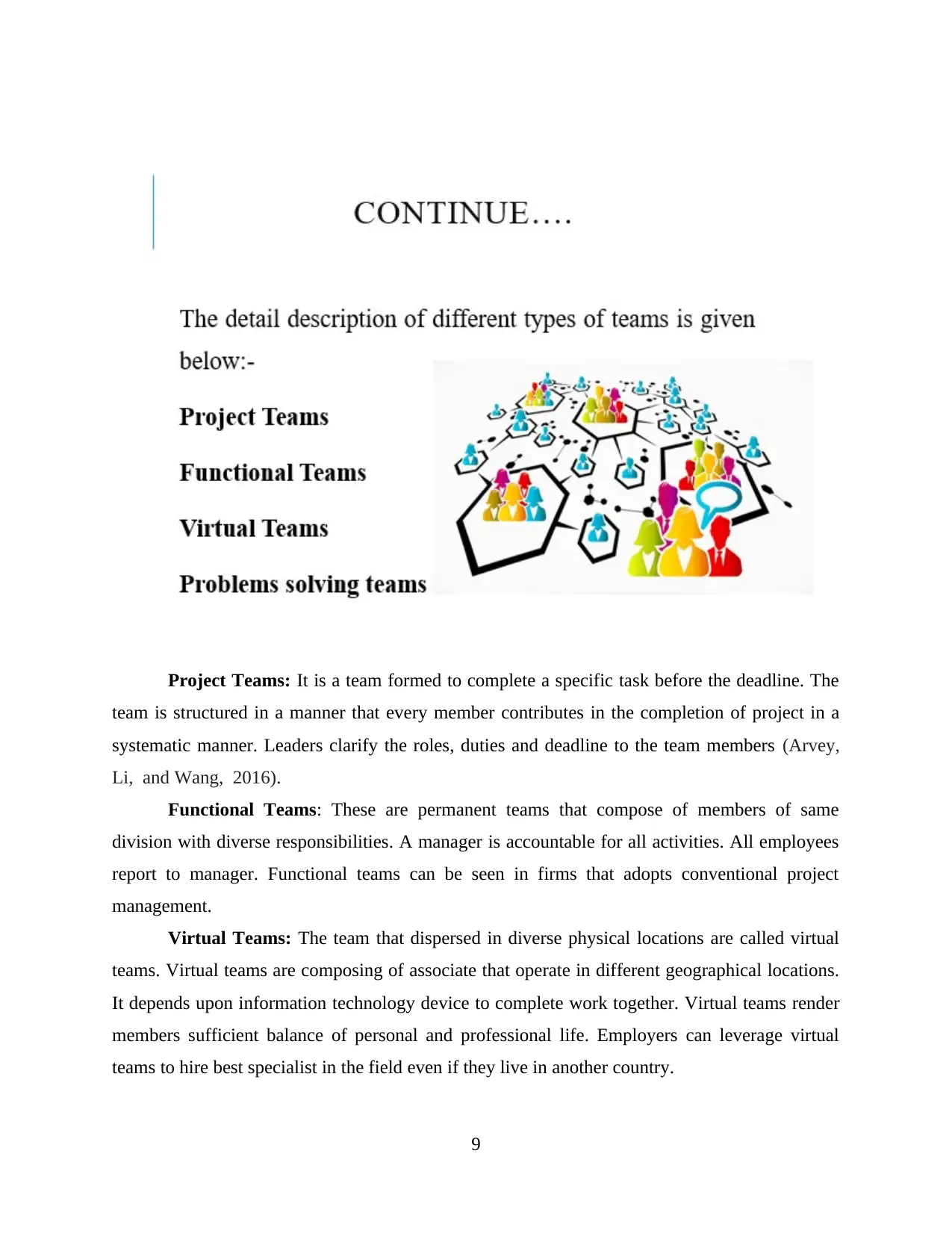
Project Teams: It is a team formed to complete a specific task before the deadline. The
team is structured in a manner that every member contributes in the completion of project in a
systematic manner. Leaders clarify the roles, duties and deadline to the team members (Arvey,
Li, and Wang, 2016).
Functional Teams: These are permanent teams that compose of members of same
division with diverse responsibilities. A manager is accountable for all activities. All employees
report to manager. Functional teams can be seen in firms that adopts conventional project
management.
Virtual Teams: The team that dispersed in diverse physical locations are called virtual
teams. Virtual teams are composing of associate that operate in different geographical locations.
It depends upon information technology device to complete work together. Virtual teams render
members sufficient balance of personal and professional life. Employers can leverage virtual
teams to hire best specialist in the field even if they live in another country.
9
team is structured in a manner that every member contributes in the completion of project in a
systematic manner. Leaders clarify the roles, duties and deadline to the team members (Arvey,
Li, and Wang, 2016).
Functional Teams: These are permanent teams that compose of members of same
division with diverse responsibilities. A manager is accountable for all activities. All employees
report to manager. Functional teams can be seen in firms that adopts conventional project
management.
Virtual Teams: The team that dispersed in diverse physical locations are called virtual
teams. Virtual teams are composing of associate that operate in different geographical locations.
It depends upon information technology device to complete work together. Virtual teams render
members sufficient balance of personal and professional life. Employers can leverage virtual
teams to hire best specialist in the field even if they live in another country.
9
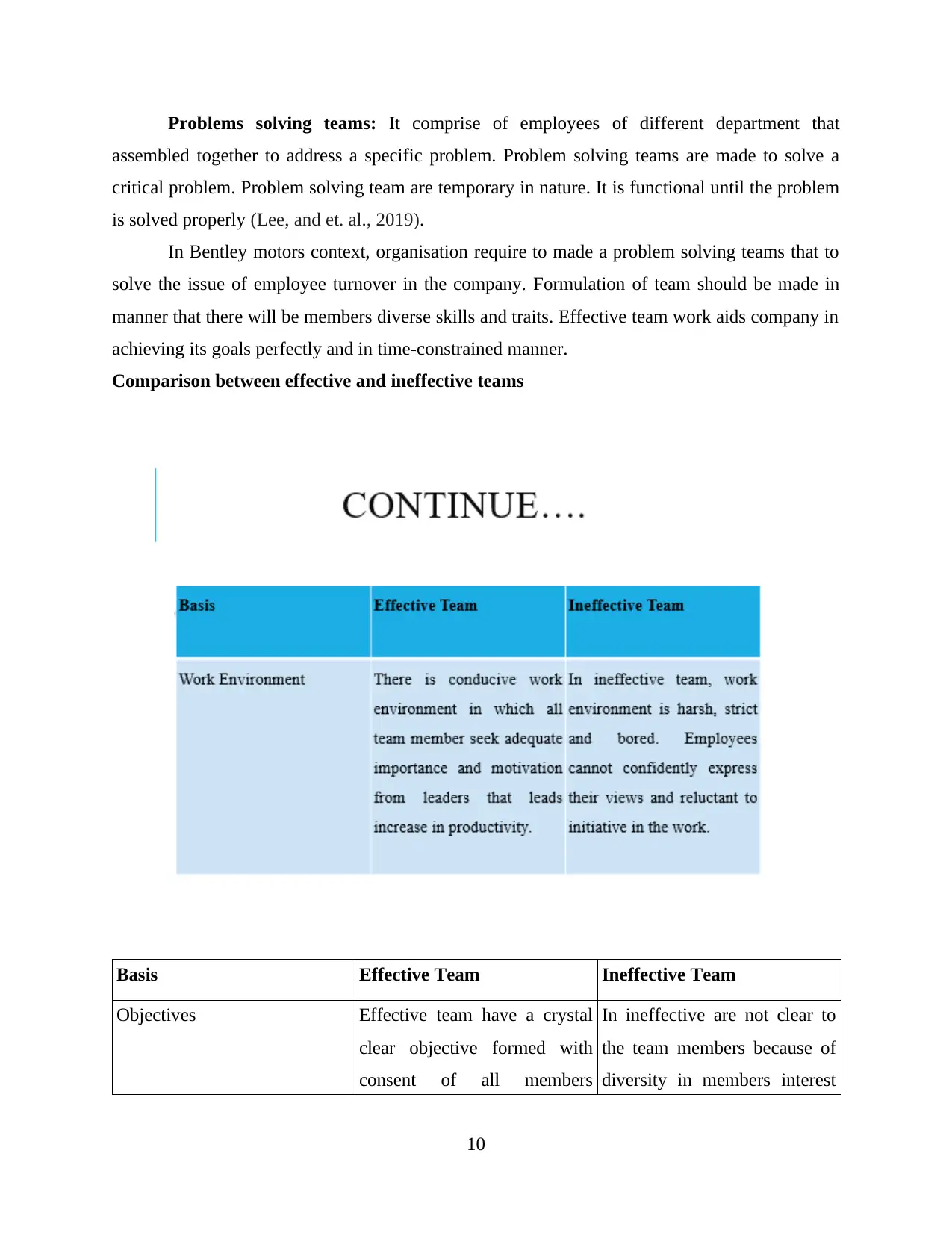
Problems solving teams: It comprise of employees of different department that
assembled together to address a specific problem. Problem solving teams are made to solve a
critical problem. Problem solving team are temporary in nature. It is functional until the problem
is solved properly (Lee, and et. al., 2019).
In Bentley motors context, organisation require to made a problem solving teams that to
solve the issue of employee turnover in the company. Formulation of team should be made in
manner that there will be members diverse skills and traits. Effective team work aids company in
achieving its goals perfectly and in time-constrained manner.
Comparison between effective and ineffective teams
Basis Effective Team Ineffective Team
Objectives Effective team have a crystal
clear objective formed with
consent of all members
In ineffective are not clear to
the team members because of
diversity in members interest
10
assembled together to address a specific problem. Problem solving teams are made to solve a
critical problem. Problem solving team are temporary in nature. It is functional until the problem
is solved properly (Lee, and et. al., 2019).
In Bentley motors context, organisation require to made a problem solving teams that to
solve the issue of employee turnover in the company. Formulation of team should be made in
manner that there will be members diverse skills and traits. Effective team work aids company in
achieving its goals perfectly and in time-constrained manner.
Comparison between effective and ineffective teams
Basis Effective Team Ineffective Team
Objectives Effective team have a crystal
clear objective formed with
consent of all members
In ineffective are not clear to
the team members because of
diversity in members interest
10
⊘ This is a preview!⊘
Do you want full access?
Subscribe today to unlock all pages.

Trusted by 1+ million students worldwide
1 out of 19
Related Documents
Your All-in-One AI-Powered Toolkit for Academic Success.
+13062052269
info@desklib.com
Available 24*7 on WhatsApp / Email
![[object Object]](/_next/static/media/star-bottom.7253800d.svg)
Unlock your academic potential
Copyright © 2020–2025 A2Z Services. All Rights Reserved. Developed and managed by ZUCOL.





